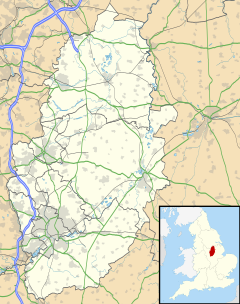Thorpe in the Glebe was a village in Nottinghamshire to the south of Wysall on the Leicestershire border. It was sometimes called Thorpe in the Clottes. Tradition has it that the village was destroyed either at the Battle of Willoughby Field or alternatively by a hail-storm. However, at the time of the English Civil War, there had been no village at Thorpe in the Glebe for nearly 200 years.
| Thorpe in the Glebe | |
|---|---|
| Hamlet and civil parish | |
 Annabell's Farm | |
 Parish map | |
Location within Nottinghamshire | |
| Area | 1.33 sq mi (3.4 km2) |
| Population | 22 (2021) |
| • Density | 17/sq mi (6.6/km2) |
| OS grid reference | SK 605262 |
| • London | 100 mi (160 km) SSE |
| District | |
| Shire county | |
| Region | |
| Country | England |
| Sovereign state | United Kingdom |
| Post town | NOTTINGHAM |
| Postcode district | NG12 |
| Dialling code | 01509 |
| Police | Nottinghamshire |
| Fire | Nottinghamshire |
| Ambulance | East Midlands |
| UK Parliament | |
| Website | https://www.wysall.com/about-thorpe-in-the-glebe.html |
The area is now a civil parish of the same name with scattered farms.[1] It reported a resident population of 22 people at the 2021 census.[2]
History
editThe placename is from the Danish word 'torp', which was a farmstead or ancillary settlement dependent on a larger village, although there are signs the area was formerly populated much earlier with evidence of flint tools and Roman pottery. At the time the Domesday Survey, Thorpe in the Glebe was then known as Thorpe Regis or King's Thorpe, and considered to be waste, with no population recorded and under two manors. William II granted away his portion amongst other manors to Hugh de Avranches, the Earl of Chester, who made the Bochard (or Bozzart) family tenants. Roger Busli granted his portion of the land to a knight Roger de Luvetot with descendants continuing to own the manor until the middle of the 13th century. William de Luvetot founded Worksop Priory in 1120 and as a result Thorpe became a parish. The village was eventually known as Thorpe Bochard (or Bochart), Thorpe Buzzard or Bochardisthorpe. These held the manors of Thorpe and Wysall until the male lineage died out by the 13th century, and both estates came to John Seagrave in Leicestershire via Margaret Bochard.[3][4] A local rector was recorded by 1251 and evidence tangible of a church noted by 1291 although little else is known.[5] The Darleys, who were residents of Wysall, became stewards for the Seagraves at Thorpe and eventually obtained the manor in around 1300. The tax records then show that Thorpe was small and not of much wealth.
Thorpe started to be referred to as Thorpe in the Glebe and alternatively as Thorpe in the Clottes in around the 14th century.[6] The land eventually descended to their relations the Armstrongs by the middle 15th century and the agricultural focus was changed to sheep rearing which needed less labour. The remaining land not in their control in the later part of the century. Enclosure of the land took place in 1491 by Gabriel Armstrong and depopulation of the village may have started to take place, although there is little evidence of this. The family also maintained control of the farming and stopped leasing out the land. Signs of wide scale abandonment was evident by 1500 and the area described as a ruin in 1534. The local church tower was still standing in 1810 but by 1844 only overgrown ruins remained, with new vicars still attending the derelict site for their inductions until 1868.[3] The remaining earthworks of the village are still evident to the present day and surround the Church Site farm, these are registered as a protected scheduled monument.[7][8]
See also
editReferences
edit- ^ "THE NOTTINGHAMSHIRE (RUSHCLIFFE AREA) DEFINITIVE MAP AND STATEMENT" (PDF). Nottinghamshire County Council. p. 24. Retrieved 13 August 2022.
- ^ UK Census (2021). "2021 Census Area Profile – Thorpe in the Glebe parish (E04008007)". Nomis. Office for National Statistics. Retrieved 13 February 2024.
- ^ a b "Village History |Thorpe in the Glebe". www.wysall.com. Retrieved 13 February 2024.
- ^ Thoroton, Robert (9 August 1677). The antiquities of Nottinghamshire extracted out of records, original evidences, leiger books, other manuscripts, and authentick authorities : beautified with maps, prospects, and portraictures / by Robert Thoroton ...
- ^ "Thorpe in the Glebe - Introduction". southwellchurches.nottingham.ac.uk. Retrieved 13 February 2024.
- ^ "Thorpe in the Glebe :: Survey of English Place-Names". epns.nottingham.ac.uk. Retrieved 13 February 2024.
- ^ "Wolds Historical Organisation". www.hoap.co.uk. Retrieved 13 February 2024.
- ^ "Thorpe in the Glebe medieval settlement, including church site and open field system, Thorpe in the Glebe - 1017743 | Historic England". historicengland.org.uk. Retrieved 13 February 2024.
